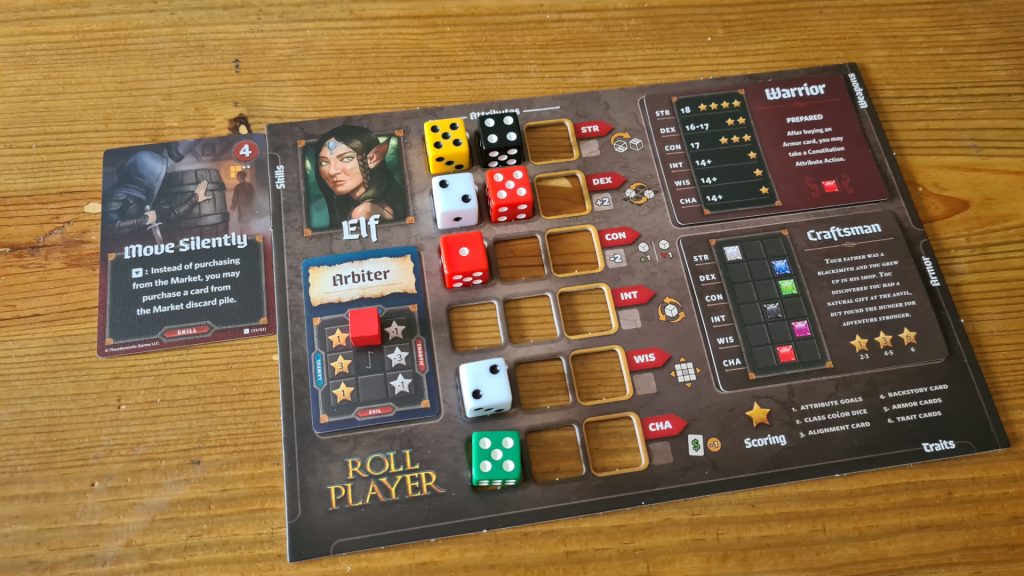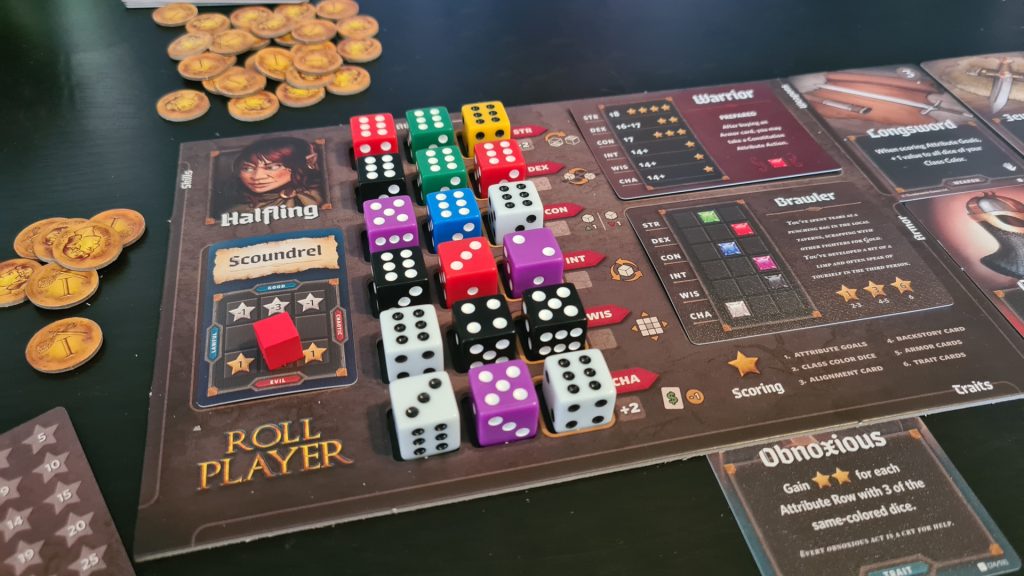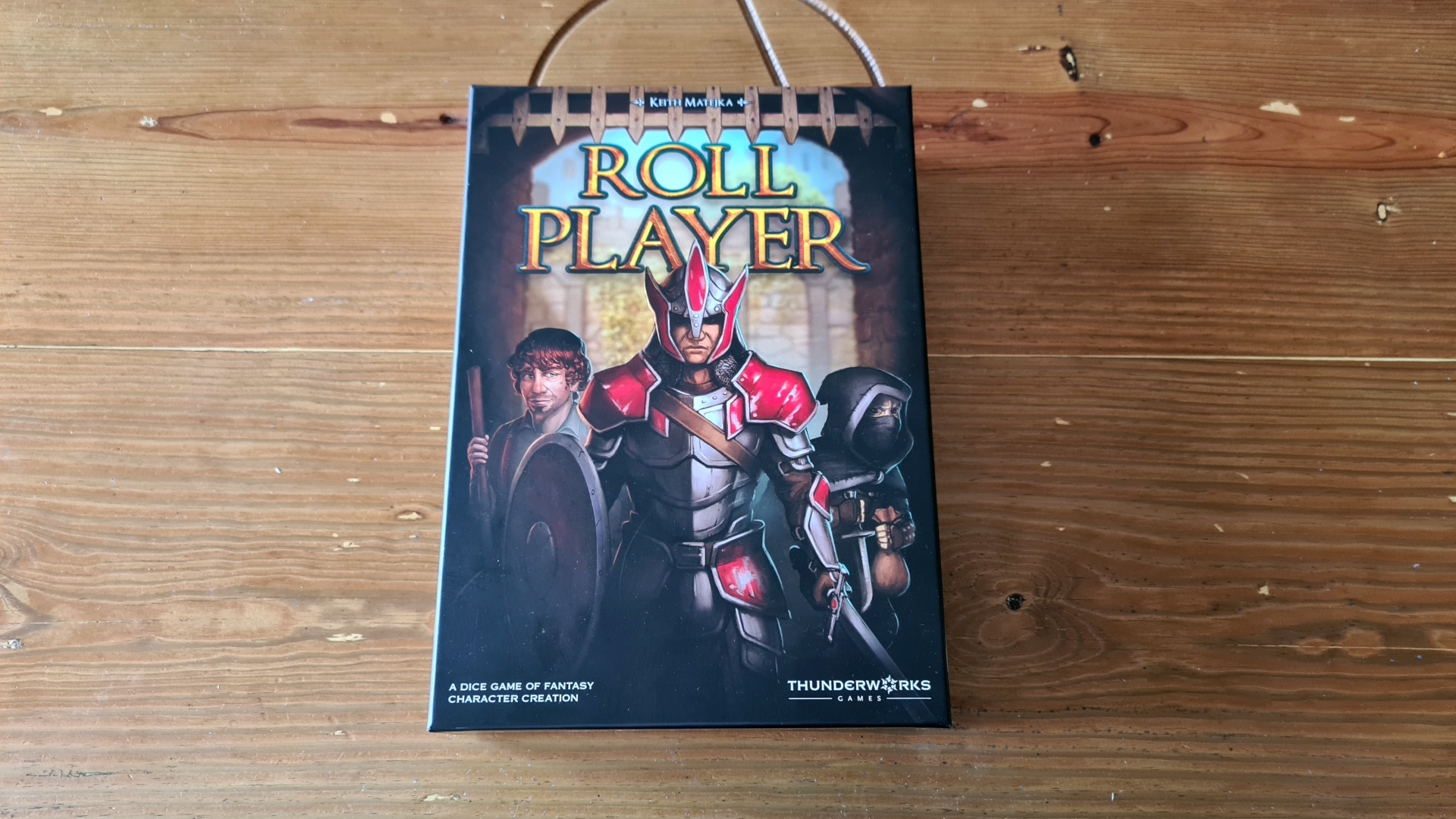Roll Player is a dice drafting board game themed around creating a Role Play Game character, from publisher Thunderworks Games. Designed by Keith Matejka, featuring artwork from JJ Ariosa and Luis Francisco, the game sees 1 – 4 players using dice to flesh out dwarves, humans, dragonborn and more. The characters’ alignments and their backstory, even their traits and gear, are taken into account in the creation process. However, is this an hour of making characters without the fun of then playing as them? Let’s find out!
As with Dungeons & Dragons, or any RPG, choosing a race is the first port of call for gamers in Roll Player. Each player takes a race board and chooses either the male or female side of the board to use. Drawing a random dice from the bag each player gains the class card of the die colour, with an alignment card and backstory card dealt out. Each of these cards offer the player an opportunity to score points at the end of the game, along with other cards brought from the market deck, which is split into 1 and 2 dot sections. Depending on the player count the players start with 6+ dice, rolling them and putting them into spaces on their player board and the game is ready to begin.
On a turn the active player draws dice from the bag, the amount equal to the player count plus one. From highest to lowest these dice are arranged on initiative cards, with a coin added to the middle cards. Note, this is a single “2” card for 2 players, the “2” and “3” cards for 3 players and so on. If two or more dice have the same number the active player can choose which order they are placed on the initiative cards. Starting with the active player everyone chooses an initiative card, instantly placing the die onto their player board.
Players are placing the dice to best complete their backstory (by placing dice of specific colours in specific attribute slots) and their class (by making the sum of their attribute values be specific values, higher than a specific value or in a range of denoted numbers). However, placing the dice also triggers bonus actions, depending on the attribute row chosen. These range from flipping a dice over for strength or increasing/decreasing a die value by 1 for constitution to being able to move your alignment cube for wisdom. In addition, the third dice placed in a row rewards the player with a gold to spend.

It’s then time to visit the market, with each player choosing to buy or discard a card from the market. Rather than going clockwise around the table, this stage is done in initiative order – based upon the cards players took in the dice drafting stage. Market cards can be sets of armour to collect for points, traits that shift a player’s alignment, skills that only that player can later perform or weapons. Only weapons are limited via hand symbols, with players able to use up to 2 weapons unless one is double handed. If a player cannot afford to, or chooses not to, the player still takes a card from the market but discards it for 2 gold.
Unclaimed dice and market cards are then discarded, with dice thrown back into the bag. Play continues with the next player clockwise around the table becoming the active player. The game keeps going until everyone has taken a total of 18 dice, filling up their attribute slots. With points earned for players alignment, gear, class colour and more, whoever has the most points wins.
Every single turn there is an important choice to make. At times players will be able to draft the right die, trigger a helpful skill and even place a die such that it helps them score for their backstory. For the most part though players will have the tough choices of what they will use their dice for, with scoring everything nigh on impossible. Perhaps the right number but wrong colour die is available but it’s late in the initiative for the market. Then, there might be the final piece of the armour set you’re collecting in the market – and someone else could swoop in and discard it. These choices only improve with repeat plays too, as you can start to lift your head out of your own board and start to notice what market cards others might be going for.
Variety to the puzzle is there in terms of what attributes you want to get all the way to 18, what colour dice you want most of and alignment, but these don’t really change the feel of one game to the next. They may change what you are going for dice wise but this is much more choosing a red die over a blue one. The market however does give some added variety in the form of skills and traits – offering unique ways to score points and abilities to use throughout the game. The same level 1 cards will always come up during the game but players will pick different cards up and thus get different scoring opportunities and abilities.

There is no getting away from the amount of maths and potential for analysis paralysis that players will find in Roll Player. Taking the dice and ignoring the market phase completely, players will be able to place a die in potentially 6 different spaces, each offering a way to manipulate an already placed dice. Next, there is the market which takes a couple of games to know what can come up, with a lot of players leaning over to read the cards in the first game. All of this is combined into the choice of the dice in every round, with placement, the abilities, what you want to buy or stop others from buying. For those that love meaty decisions it’s ideal, but some might slow the game down to a plod as they attempt to calculate things.
The design of the player boards is certainly something to be commended. Whilst not exactly dual-layered, being punched out holes, they still aid the game experience in the same way. By featuring slots for the dice there’s no way for them to rattle around on top of a board, so slight nudges don’t cause chaos. Being double sided is also a great touch, flipping over to be able to create a character of either gender. This could have been an opportunity to have even more variety in the attribute buffs and nerfs but for equality between the genders it’s great to see them be the same.
Not every aspect of the production is quite as high as the chunky dice and the player boards though. The charism tokens get lost a little next to the pile of gold coins. Also, while some of the dice are supposed to be gold they are in fact yellow in colour. This may sound like a small nitpick but gold would have been a bit more eye-catching, in a game that relies on the colourful dice for much of its flair.
Roll Player almost deserves to be boring. Theming wise it takes the fun of creating a character with flowing lore and backstories and turns it firmly into a stats-fest. Often the luck of the dice in games can win or lose someone the game. Well, not only is there a brilliant puzzle in those stats, the way players draft the dice – balanced with the initiative at the market – even crushes the luck out of the game. This is before players get the chance to manipulate dice via bonus actions, or trigger any abilities. Roll Player is numbers heavy though, and anyone that gets analysis paralysis could certainly get bogged down by the amount of choices. Still, the fun of the puzzle is what has earnt it a space on my gaming shelf!
(Editor’s Note: Roll Player was provided to us by Asmodee for the review. The game is currently available from local board game stores! Find your local store here.)

